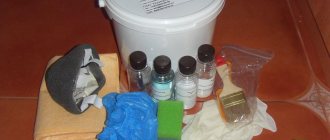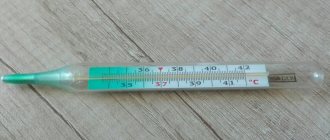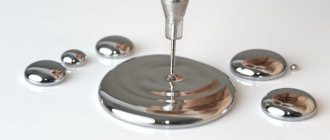Share on social media networks:
The question of how to flush mercury in the toilet is quite popular on the Internet. And the matter is truly serious and requires detailed consideration. Mercury thermometers are slowly but surely being replaced from everyday use by electronic ones, but progress has not yet reached all residents of our country. Sometimes it’s a pity to throw away an old thermometer, since it’s still working, and older people don’t trust newfangled devices or simply don’t want to pay more for a modern device. As long as this relic of the past is still found in our apartments, the topic of broken mercury thermometers will be relevant.
How to wash the floor after a thermometer breaks?
Every day it is necessary to wash the floor and surfaces that have come into contact with mercury with a soap-soda solution or water with the addition of a chlorine-containing disinfectant.
Interesting materials:
How to change the font in Windows 10? How to password protect Windows 10? How to burn a CD in Windows 7? How to write data to disk in Windows 7? How to record Windows 10 computer screen? How to burn files to a Windows 7 disk? How to burn ISO to disc in Windows 10? How to burn an ISO image to disk in Windows 10? How to burn an iso image of Windows 10 to a USB flash drive? How to burn an mp3 disc to a machine on Windows 7?
What to do if mercury gets into the toilet?
As a rule, this problem is associated with a broken mercury thermometer. Not only playful children can break such a thermometer. Quite often, adults break them, accidentally dropping them on the floor or shaking off the mercury column to a minimum. Usually mercury ends up on the floor of the room, but sometimes it ends up in the toilet.
It is difficult to imagine a situation where a person somehow managed to measure his temperature in such a way that the thermometer fell into the toilet. How does the metal get there? Most often, children, and sometimes adults, having broken the device, in panic, without thinking, out of ignorance and other reasons, try to flush “evidence from the crime scene” down the toilet. What to do if, for some reason, mercury ends up in the toilet?
The effect of mercury on the human body
If you have already tried to wash off the mercury, you are probably convinced that it remains at the bottom. The mercury balls are not so light that they can go away with the flow of water.
First of all, victims are interested in why such an amount of mercury is dangerous for them:
- Mercury itself, as is known, is not dangerous, but its vapors can cause unpleasant consequences in the form of nausea, vomiting, diarrhea, dizziness, and a feeling of heaviness.
- Also, contact with these toxic vapors can cause feelings of anxiety and depression.
- With prolonged exposure, more tragic consequences are possible in the form of disruption of the nervous system or Alzheimer's disease.
Important! Let's be honest: the amount of mercury that leaked from one thermometer does not pose a particular danger to an adult healthy person, but it is quite dangerous for children, the elderly or people with poor health. So, be that as it may, you need to get rid of the remaining mercury.
How to remove mercury from the toilet at home?
The most sensible advice, of course, is to contact the Ministry of Emergency Situations or an environmental service for mercury disposal, if there is one in your locality. The specialists there know exactly how and what to do in your situation, although, of course, you will not be praised for throwing mercury into the toilet. Specialists have all the tools and skills for mechanical or chemical demercurization.
If for some reason you do not want to contact the services of special services, then you should do the following:
- First of all, you need to get the visible mercury balls. First, put rubber gloves and a respirator on your hands; although the mercury is under water, you can inhale its vapors.
Important! Don't try to do this with your hands or a brush. This will only lead to the fact that the balls will break up into smaller fragments, which will still stubbornly not be washed off, and will be much more difficult to collect.
- You can try to collect mercury with a large rubber bulb, which you can easily buy at a pharmacy, or with a syringe without a needle. Just try to suck up the ball, and then place it in a jar of water that is sealed tightly.
- After all visible particles have been collected, you can pour a strong solution of potassium permanganate or a soap-soda solution into the toilet. The latter is easy to prepare: you need to thoroughly dissolve 40 g of laundry soap shavings and 50 g of soda ash in 1 liter of water.
- How to flush mercury from the toilet? In order for the remaining mercury to go down the drain, you need to throw toilet paper or sawdust for cat litter into the toilet. Try repeating the procedure several times.
Important! Over time, the dangerous substance will go down the drain, but, frankly, there is nothing good about it. Mercury is heavier than water (sinks easily) and can settle in the nearest knee, leaving you or your neighbors still exposed to mercury vapor, only in small quantities. And you will harm the environment. Needless to say, throwing mercury down the toilet is not a good idea.
- After all procedures, you need to thoroughly ventilate the room, ideally for 24 hours. It is advisable to remove animals, children, and people with poor health from the apartment for at least a day.
Important! To prevent poisoning, doctors recommend taking 3-4 tablets of activated carbon.
- Collected mercury must be taken away from the house. It would be more correct to call the sanitary and epidemiological station or the Ministry of Emergency Situations and ask where exactly to dispose of it.
Important! At any rate, don't throw mercury down your home's trash pit. It's better to find a trash container on the street. You can take out and bury the collected metal in some vacant lot away from houses.
- It is also recommended that after all procedures, call specialists to your home, who will measure the level of mercury vapor with a special device.
Mercury spill: how to behave and what to do
Mercury is widely used both in various areas of industry and in everyday life: medical thermometers, devices for measuring blood pressure, fluorescent lamps, etc. Mercury vapor is very dangerous for humans, so even a broken thermometer poses a serious threat to health. Mercury evaporates at room and even zero temperatures. It easily penetrates into any crevices, is adsorbed by porous bodies and remains there for a long time, being a source of indoor air pollution that is dangerous to humans.
When you inhale air containing mercury vapor in a concentration not exceeding 0.25 milligrams per cubic meter, the latter is completely retained in the lungs. In the case of higher concentrations, another route of penetration into the body is possible - through intact skin.
The clinical picture of poisoning develops within 8-24 hours and is expressed by general weakness, headache, lack of appetite, pain when swallowing, and fever. Somewhat later, soreness of the gums is observed (bleeding, the appearance of a dark border of mercury sulfite), abdominal pain, and gastric disorders are bothersome. Sometimes the affected person develops pneumonia. Digestive disorders range from loss of appetite and nausea to vomiting (sometimes with blood).
Characterized by a decline in cardiac activity, fainting is possible. There have been known fatalities.
What to do if you break a thermometer or spill mercury?
— Open the vents, windows for access to fresh air, eliminate drafts;
— Remove people from the premises, especially children;
— Limit access of people to the room (close doors) in order to reduce the spread of mercury vapor into adjacent rooms;
— Prevent the spread of mercury into adjacent rooms on shoes (lay a mat moistened with a solution of potassium permanganate at the entrance).
Mechanical demercurization process (mercury removal):
—
Using rubber gloves, carefully and carefully collect all thermometer fragments and mercury balls into any sealed container with a tight-fitting lid (for example, a glass jar with a plastic lid). Keep in mind that the specific gravity of mercury is very high (13 times heavier than water) and when it falls, it can scatter into several small balls and, of course, roll into any crack. A medical bulb with a thin tip and an enamel scoop will help in this work. It must be remembered that the collection of mercury drops and fragments must be carried out from the periphery to the center of the room. Drops of mercury can be removed with newspaper soaked in water, foil, cotton wool soaked in a solution of potassium permanganate, and also with tape.
— Never use a vacuum cleaner to collect mercury. Firstly, the vacuum cleaner heats up and increases the evaporation of mercury, and secondly, air passes through the engine of the vacuum cleaner, and an amalgam is formed on the engine parts, which are made of non-ferrous metals, after which the vacuum cleaner itself becomes a distributor of mercury vapor.
— If mercury gets on the carpet, then you need to carefully roll it up from the periphery to the center so that the mercury balls do not scatter throughout the room. It is advisable to place the carpet in a whole plastic bag or simply wrap it in plastic film, also from the periphery to the center, and take it outside. Then hang the carpet up, lay a cellophane film under it to prevent mercury from contaminating the soil, and beat it with gentle blows. It is also necessary to let the carpet hang and air outside.
Chemical demercurization process (mercury removal):
At home, the simplest demercurizers are potassium permanganate (or simply potassium permanganate) and a soap-soda solution, a solution of chlorine-containing bleach “Belizna” at the rate of 1 liter of product per 8 liters of water (2% solution). It is necessary to alternately use both methods: prepare a 0.2% aqueous solution of potassium permanganate (20 g per bucket of water), and treat the contaminated surface with this solution using a brush, broom, or spray gun. After 1 hour, it is necessary to wash off the reaction products with a soap-soda solution - % soap in a 5% aqueous solution of soda or a chlorine-containing solution. These operations must be repeated for several days, 2-3 times a day.
At the end of the work, all waste from the thermometer that you managed to collect in a sealed container, in order to prevent further contamination of the territory and home, must be handed over to an organization that has safe technologies for the demercurization of premises and mercury waste.
Source
Actions in case of a broken mercury thermometer
If you break a mercury thermometer indoors, do not flush the gray matter down the toilet. You can get rid of harmful metal faster if you don’t panic and listen to the following recommendations:
- Do not use a vacuum cleaner to collect mercury beads. It will absorb the balls, and on the other side we will receive a stream of air “enriched” with poisonous mercury vapor. Evaporation will increase as the mercury inside the vacuum cleaner heats up.
- To collect mercury balls, you cannot use a broom, broom, mop, or rag, since, thanks to your manipulations, they will disintegrate into small fragments, scatter throughout the room, and seeing and collecting them will be even more problematic.
- Be sure to protect your hands and respiratory system. Isolate the room itself.
- Remove animals, children and people in poor health from the contaminated premises.
- You need to collect mercury carefully: carefully sweep individual particles onto a piece of paper with a soft brush or a scraper with a rubber tip. Collect small balls using tape or wet newspaper.
- If mercury gets on the carpet, it is better to cut out a piece of the carpet and throw it away.
Important! When collecting mercury in the room, windows should be closed, fans, air conditioners, and heaters should be turned off.
- Inspect the surface and all the cracks around it with a flashlight. The mercury will glow. From hard-to-reach places, balls can be collected with a medical bulb or a syringe without a needle.
Important! All clothing that may have gotten mercury on it, the respirator, and gloves must be thrown away; clothing should not be washed in a washing machine.
- After all manipulations, it is necessary to ventilate the room for 24 hours.
Important! Liquid metal is a substance of the first hazard class. The maximum permissible concentration is 300 ng/cubic meter.
What can't you do?
Next we will talk about some tips that are quite often found on forums when discussing the topic of how to flush mercury in the toilet:
- If we perceive the recommendation to concrete the toilet and leave the city as a joke, then some may perceive pouring Coca-Cola into the toilet for 2 weeks as a really working remedy. Such actions will not bring any results in the fight against settled metal.
- There are people who advise using ferric chloride. In reality, it is toxic, and, fortunately, it is not sold on every corner. The same applies to 100% nitric acid.
- You should also not believe that mercury balls will stick in friendly rows to a magnet or copper wire as soon as you lower it into the toilet.
Important! If you have plumbing skills, you can use the recommendation to disconnect the toilet and remove the mercury from it, but this, as they say, is not suitable for everyone.
How can you remove mercury?
Before you remove the mercury from the thermometer from the floor, you need to know what can be used in this case and what cannot be used. The following will be useful for cleaning: plastic trash bags, sheets of paper or cardboard, rubber spatulas, brushes, enema, tape. How to remove large mercury:
- visible particles are driven onto a sheet of paper with a scraper, brush, or cardboard;
- It is convenient to collect droplets with a pipette or rubber bulb.
How to remove mercury – its small drops:
- Unnoticeable particles are removed with tape - the sticky part of the tape must be pressed against the surface and slowly lifted, discarded.
- Use shaving cream and a brush; the foam helps catch small balls. It covers the place where the thermometer broke, then the product is carefully scraped off.
- A crumb of bread or dough will come in handy. A small piece should be pressed to the area where small drops accumulate and thrown into a jar of water.
- Items used for cleaning are packed in plastic bags.
Is it possible to collect mercury with a magnet?
Many people advise collecting mercury with a magnet. However, this method will not work to get rid of toxic balls. Although the substance belongs to liquid metals, it is diamagnetic; when a magnet approaches, droplets will be repelled from it, so with the help of this improvised means you can only unsuccessfully drive mercury balls across the floor.
How to remove mercury with a vacuum cleaner?
Before you remove mercury from the floor with a vacuum cleaner, it is important to know that doing this is strictly prohibited. The substance will pass into the engine of the equipment, forming a toxic film on its parts. Then, when you turn on the vacuum cleaner, it will begin to heat up, mercury microdroplets under the influence of hot air will be dispersed throughout the apartment. This promotes strong evaporation of the substance. If the vacuum cleaner was used in this case, it must be disposed of immediately.
Where to put the collected mercury?
Remains of the thermometer and collected mercury should not be thrown into the garbage disposal. They must be submitted to the relevant service. It is also not worth making independent attempts to dispose of it (burying it in the ground or pouring it into the river). Only specialists have the right to deal with such matters.
If at least 2 grams of mercury evaporate, it will pollute 6 thousand cubic meters of air. When released into open spaces, mercury vapor spreads at maximum speed. Throwing mercury waste into the trash can endanger animals and people without them even realizing it.
In large cities, mercury waste is handed over to collection points of the SES and the Ministry of Emergency Situations. But in small towns and villages, of course, there are no such services. Local residents have to travel a long way or cope on their own.
Note! Not long ago, an interactive map appeared, which marks places where you can take old thermometers and other items hazardous to the environment. The number of such points is constantly growing.
Have you thrown mercury into the trash?
Not really
Video material
In order to avoid a repetition of such a situation, replace mercury thermometers with electronic ones, especially if you have children and you don’t want to worry about how to flush mercury down the toilet. In any case, you should not panic, because it is in this state that you will make more mistakes than correct actions. Think soberly and clearly, concentrate on the task at hand and figure out how to properly and quickly dispose of harmful metal. The tips from this article will help you navigate this serious matter.
Routes of penetration of mercury from a thermometer
When producing a thermometer, mandatory hardening is carried out for 1 thousand hours. This makes the glass extremely resistant to impact, friction, and abrasion.
Therefore, mercury from a thermometer can enter the environment only if the thermometer is broken or through microcracks in the bulb. The probability of independent penetration of a substance through glass is zero, since the glass mass is an inert compound and does not react with liquid metal.
Liquid metal can penetrate the human body:
Why remove mercury?
Mercury vapor “running” along the thermometer scale is harmful and dangerous to humans. If you inhale them, you can get poisoned. Mercury belongs to the first class of danger, representing a cumulative poison.
It is the only metal that is in liquid form at room temperature. In the open air, mercury evaporates. Because of their shape, mercury balls easily roll from place to place around the apartment, getting stuck in the carpet pile, tiny crevices and cracks. They can get and settle even on animal fur.
Many European countries have already abandoned the use of mercury thermometers. In Russia, they still adhere to the opposite point of view: they believe that such thermometers provide maximum accuracy in readings.
Important! The mercury used in thermometers today is unique. Its volume changes gradually during the cooling and heating process. Evaporating, it has neither odor nor color. That is, you can only notice mercury in the form of a ball. An undetected droplet will evaporate for months.
Mercury in the air can be detected using an improvised indicator. It will help determine whether all the mercury was collected when the thermometer broke. Components, if necessary, are ordered at the pharmacy:
- Filter paper is cut into small strips and dipped into a solution of copper sulfate. It must dry.
- Already dry, moisten it in a potassium solution. It will change color to brown.
- The strips are rinsed with water, dried and laid out in the dark.
- If there are dangerous vapors left in the air, the paper will turn pink.
Have you ever collected mercury beads from a carpet?
Not really
For any mercury spill
List of articles:
Expert Instruction
A thermometer was accidentally broken in the apartment. It’s not clear what to do, I remember school lessons on life safety, like, where they explained how to behave in such cases. I decided
There was also a very unpleasant situation with a glass thermometer using mercury. He let his daughter take her temperature when she got sick, but he didn’t look at what it was showing and didn’t care
The thermometer broke. They removed it themselves. They called for an inspection. Experts found traces of mercury and discovered a serious excess of contamination. Everything was removed and processed. M
Preparing for cleaning
The success of assembling mercury depends on how well you prepare for this event:
- First of all, pets are taken from the room and children are taken to a safe place.
- If possible, reduce the room temperature to 18 degrees.
- It is necessary to work only with rubber gloves and a fabric mask soaked in a soda solution. Feet are protected with shoe covers, which must be removed and disposed of after work.
- It is best to collect mercury in a glass jar with a tight-fitting lid - it will not leak out of it. You can pour water or potassium permanganate into it. The broken thermometer is placed in a separate container.
- The entrance door to the room is closed, and the window, on the contrary, is opened.
- To work you will need: a weak solution of potassium permanganate, a rubber bulb, a syringe, tape and thick sheets of paper.
- The entrance is covered with a large rag soaked in a manganese solution.
How to delete?
The upcoming work area needs to be carefully inspected and the fragments carefully removed from the floor so as not to get injured:
- Press the rubber bulb with your fingers (a vacuum should form) and bring it to the mercury drop. The metal is transferred into the prepared container using a syringe. Instead of a bulb, you can use a medical syringe.
- It is convenient to push mercury balls towards you with sheets of paper, and “catch” small remains with tape.
- If the collection is delayed, every 15 minutes you need to take a break and go out into the fresh air.
- Neutralization of mercury occurs by collecting in the direction from the edges to the middle.
- The jar with the contents is tightly closed and placed in a dark place. It is important that sunlight cannot penetrate there: it will provoke increased evaporation of the metal.
- Not only the jar of mercury must be disposed of, but also the gloves, mask, and shoes used for cleaning.
- If the thermometer fell and broke, and the mercury was not found, it is important to understand that it could not evaporate in a short period. This means that it is insidiously “hiding” somewhere (in cracks or under the baseboard). In this difficult situation, the most correct thing is to call a professional service.
Toxic dose for humans
The toxic dose of a toxic substance depends on the individual characteristics of the person, the age of the victim, the route of entry of mercury into the body, and the duration of exposure to the poison. Separately, one should take into account the form in which the liquid metal was at the time it entered the body.
Table 1. Lethal doses of mercury
| Form of mercury | Lethal dose | |
| In an adult | In children | |
| In inorganic compounds | 10–42 mg/kg | 10–42 mg/kg |
| In organic compounds | 10–60 mg/kg | 10–60 mg/kg |
| Metal in the form of vapors | 2.5 g | |
| Oral Compounds | From 0.1–0.3 g to 3 g | |
Chronic intoxication develops when the concentration of toxic metal vapors in the air is from 0.001 to 0.005 mg/m3. For acute inhalation injury, the MPC is 0.13–0.80 mg/m3.
How dangerous is mercury?
Statistics say that most cases of poisoning by silver fulminate vapors are associated with broken thermometers. Most people immediately try to remove the remains of a broken thermometer using improvised means, which is strictly prohibited. Conventional household cleaning products that are present in every home are not able to affect this element. For contact with mercury, employees of special services use professional means available exclusively to experts. The main danger is the fact that evaporation begins from the first minute of the incident. The situation is aggravated by the fact that most often this happens in poorly ventilated areas. Important: one broken thermometer can contaminate the air in a room of 10,000 square meters.
Prevention
If the thermometer breaks, then do not panic. We need to minimize the consequences of this event.
Algorithm for mercury spills indoors:
If it is impossible to collect the heavy metal in full, then demercurization specialists should be called. Carpets, other things, upholstered furniture must be disposed of after contact with mercuric chloride.
Do not do the following:
And remember, your case is not unique. Don't panic, take all necessary steps to neutralize the area. If you cannot cope with your excitement, then call emergency services.
Source
What to do if you have mercury poisoning
There are clear algorithms for providing first aid and treating victims of intoxication with mercury and its compounds. They differ depending on how the toxic substance entered the body.
First aid
If the victim has inhaled mercury, he should be removed from the affected area. It is important to provide the patient with a constant supply of fresh air. Then lay or sit down, ensure peace and call an ambulance.
If accidental ingestion of a ball of heavy metal or its salts occurs, the contents of the stomach should be evacuated.
Method of flushing the gastrointestinal tract system:
After washing the stomach, give the victim milk or protein water - beat 2 egg whites with 1 liter of water - and take him to a medical facility.
Treatment
Treatment of victims of contact with mercury vapors or compounds is a long and complex process. The decay and half-life of toxic metal metabolites ranges from 42 to 75 days.
Important! In case of chronic and acute intoxication, treatment is carried out only at a medical institution. If the patient's condition improves after long-term micromercurization, the patient is transferred to outpatient observation after 3 weeks.
An acute process requires a longer period of stay in a medical institution. The course of therapy is determined individually for each patient.
Drug therapy involves the use of antidotes:
In case of inhalation damage, the administration of unithiol using inhalation devices and nebulizers is effective. The duration of the course is at least 10 days. After some time it is repeated.











